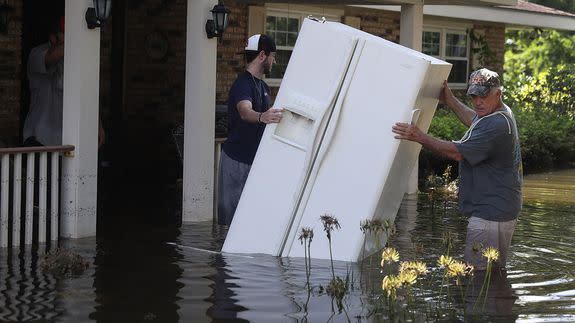Deadly Louisiana deluge had a major climate change assist, study finds

The 7.1 trillion gallons of torrential rainfall that a storm dumped on Louisiana in August, leading to a flooding disaster that killed at least 13 people and caused more than $1 billion in damage, had a direct link to human-caused global warming, a new study finds.
In short, while these events are still rare — on the order of about once every 1,000 years at the local level — they used to be far more infrequent, the study, released Wednesday, concludes.
SEE ALSO: Why the extreme Louisiana floods are worrying but not surprising
Scientists studying the storm using readings from rain gauges as well as powerful computer models have determined just how unlikely the rains were, teasing out the component of the event that was likely human-caused.
Like many other studies examining extreme events in recent years, the new research, which has been submitted to the online journal Hydrology and Earth Systems Discussions, points to the conclusion that global warming is an increasingly influential player when it comes to tipping the odds in favor of extreme events.
This is particularly the case when it comes to extreme heat and heavy precipitation events, the researchers say.
So much rain fell during the three-day deluge from August 12 to 14 — 25.5 inches in Livingston, Louisiana near Baton Rouge — that rivers swelled to several feet above their all-time historical markers. The Amite River in Magnolia, Louisiana, for example, rose to 58.56 feet, more than 6 feet above the old record set in 1977.
"We find that the probability of a comparable event to occur anywhere in the region has increased over time and that this increase is caused by climate change. The increase of odds is at least 40 percent, most likely a doubling (100 percent)," Karin van der Wiel, lead author of the study, told Mashable in an email.
"That means that what is a 1-in-30 year event now, used to be a 1-in-50 year event in preindustrial times (1900)," added van der Wiel, who is a research scientist at the NOAA Geophysical Fluid Dynamics Laboratory in Princeton, New Jersey.
The new study is part of a "rapid climate attribution" push by many climate scientists to speed up the time it takes to inform the public and policymakers about the role that global warming may have played in a newsworthy extreme weather event.
The World Weather Attribution project is an international effort, and this study enlisted the help of several scientists, such as van der Wiel, who are not formally part of this group.
The study involved performing a statistical analysis of rainfall observations and using high-resolution climate models to simulate the odds of such a heavy rainfall event with and without global warming.

Image: joe raedle/getty Images
Specifically, the study examined how the probabilities have changed between the early part of the 20th century and the early part of the current century.
Bolstering the scientists' conclusions, the modeling data and the statistical analysis showed similar results.
The odds of torrential rainfall amounting to more than 2 feet within three days in a specific town such as Livingston is closer to 1-in-450 years or possibly over 1-in-1,000 years, van der Wiel said.
However, the study looked closely at the changing regional risk of an event like this, since climate models are not capable of simulating conditions over such small areas.
Studies like these may not provide comfort or answers to people still cleaning up in the aftermath of these types of storms. However, the changing odds for these events will affect insurance companies and the rates they set, as well as local and state government policies in the future as climate change increases the chances that storms such as these will occur.
The study did not analyze the weather system that caused the event itself to see how common such slow-moving hybrid tropical low pressure areas are, and whether the odds of such systems are changing. That, Van der Wiel says, would be a far more complicated task.
"We haven't separated large rainfall events into those related to tropical cyclones, frontal systems or stationary lows as in August 2016. That would be a very interesting topic for further study," she told Mashable.
The study will undergo an online, open peer review process on the journal's website.
